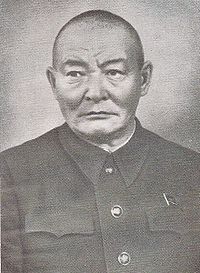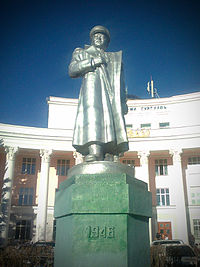- Khorloogiin Choibalsan
-
For other uses, see Choibalsan (disambiguation).
Khorloogiin Choibalsan
Хорлоогийн Чойбалсан
Head of State
Chairman of the Presidium of the State Little HuralIn office
24 January 1929 – 27 April 1930General Secretary Ulzhiygiyn Badrakh
Bat-Ochirin Eldev-Ochir
Peljidiin GendenPreceded by Jamtsangiin Damdinsüren Succeeded by Losolyn Laagan Prime Minister of Mongolia In office
24 March 1939 – 26 January 1952General Secretary Banzarzhavin Baasanzhav
Dashiyn Damba
Yumjaagiin TsedenbalPreceded by Anandyn Amar Succeeded by Yumjaagiin Tsedenbal Personal details Born February 8, 1895 Died January 26, 1952 This is a Mongolian name. The given name is Choibalsan, and the name Khorloogiin is a patronymic, not a family name.Khorloogiin Choibalsan (Mongolian: Хорлоогийн Чойбалсан) (February 8, 1895 — January 26, 1952) was the Communist leader of the Mongolian People's Republic from the 1930s until his death.
Contents
Life
Choibalsan originally trained as a Lamaist monk. He made contact with Russian revolutionaries when he traveled to Siberia. He founded[citation needed] his first revolutionary organization in 1919 and in 1921 joined with Damdin Sükhbaatar to form the Mongolian People's Revolutionary Party. After the Mongolian and Soviet Red Army forces entered Urga in 1921 and established a pro-Soviet government, Choibalsan became deputy war minister.
Over the following years Choibalsan came to dominate his country's leadership and by about 1940 his position was unrivaled in his own country. He served both as head of state (Chairman of the Presidium of the State Little Hural, 1929–1930) and head of government (Chairman of the Council of People's Commissars, 1939–1952). He is sometimes accorded the military rank of Marshal.
Choibalsan was a close follower of the Soviet leader Joseph Stalin and emulated his policies in many ways including the ruthless elimination of rivals for power and harsh treatment of landowners. Choibalsan rose to power with Soviet backing, given as the result of Stalin's displeasure with Mongolian communist leader Peljidiyn Genden, who in 1936, was removed from power. Choibalsan, a strong ally of Joseph Stalin, gained power.
Stalinist purges
Main article: Stalinist purges in MongoliaUnder Choibalsan, many purges of enemies of the people were conducted. These focused on religious figures, the former aristocracy, and on political dissidents. Estimates of the number of people killed vary considerably, but are generally substantial. A common estimate is that some 30,000-35,000 people, mostly lamas, were killed from 1921–41, most of them in late 1930s.[1] Choibalsan also became the centre of a personality cult modeled on that of Stalin. For example, Bogd Khan Mountain was named after him in the 1950s.
Foreign policy
While Choibalsan could not—and did not—maintain an independent foreign policy course, it is too simplistic to portray him as a Soviet puppet with no agenda of his own. Choibalsan was a Mongolian nationalist, and he never gave up a hope of uniting all of the Mongols under the auspices of the Mongolian People's Republic. Choibalsan's Pan-Mongolist vision was as unambiguous as it was unrealistic. Until 1945 he encouraged an ethnic insurgency in Eastern Xinjiang (with Stalin's support), with an eye to strengthening the MPR's influence in the region and possibly extending it beyond Xinjiang, to Gansu and Qinghai. In August 1945, the MPR declared a war on Japan and participated in the Soviet invasion of Inner Mongolia. Choibalsan hoped to use the occasion to wrest Inner Mongolia from China's hands. But in August 1945 Stalin concluded a treaty with China, which guaranteed important Soviet interests in the Far East, as well as Outer Mongolia's independence. With solid gains in his hands, Stalin rebuffed Choibalsan's pan-Mongolian dreams, which would inevitably destabilize Sino-Soviet relations and jeopardize the Soviet position in post-1945 China. Choibalsan swallowed his pride, but he continued to petition Stalin about Inner Mongolia until 1949. The Soviet Premier's biggest concession was to let Choibalsan run "quiet" propaganda activities in Inner Mongolia for national self-determination.
Further career
During his rule considerable improvements in the country's infrastructure, roads and communication lines were made with Soviet assistance, and steps were taken toward improving the country's literacy rate.
Choibalsan held the position of Prime Minister until his death in Moscow on January 26, 1952. His death concerned the aging Joseph Stalin who commented, "They die one after another. Shcherbakov, Zhdanov, Dimitrov, Choibalsan... die so quickly! We must change the old doctors for new ones."[2] Under torture, prisoners seized in the Soviet investigation of the alleged Doctors' Plot were compelled to produce evidence to 'prove' that the Kremlin doctors, led by Stalin's own physician, had in fact assassinated Choibalsan and the others mentioned by Stalin.[2]
Legacy
Choibalsan's image in modern Mongolia is mixed; many people still consider him to be a Mongolian hero, but his critics claim that this is merely the result of his propaganda and personality cult. Some Mongolians believe that Choibalsan was merely a puppet of Stalin, and had little choice in his actions. For its part, Choibalsan's party, the Mongolian People's Revolutionary Party, criticized him for committing "errors", including the establishment of the personality cult, in 1956, in line with the criticisms of Stalin made slightly earlier by Nikita Khrushchev in the Soviet Union. Today, it claims that Choibalsan was a tyrant, but claims that the party was just as much victimised by him as were other Mongolians — many party members, particularly followers of Genden, were purged during his rule. In any case, the capital of Dornod aimag (formerly called Bayantümen) continues to carry his name, and his statue still stands in front of the Mongolian State University founded by him in 1942.
Notes
- ^ Twentieth Century Atlas - Death Tolls
- ^ a b Simon Sebag Montefiore, Stalin: The Court of the Red Tsar, Orion Books Ltd, London, 2004, p. 634
External links
- A Forgotten Purge by Timothy May, Department of History, University of Wisconsin–Madison
- Mass grave uncovered in Mongolia RTÉ News, Thursday, 12 June 2003
Preceded by
Jamtsangiyn DamdinsürenPresident of Mongolia
January 24, 1929 - April 27, 1930Succeeded by
Losolyn LaaganPreceded by
Anandyn AmarPrime Minister of Mongolia
March 24, 1939 - January 26, 1952Succeeded by
Yumjaagiin TsedenbalPrime Ministers of Mongolia (List) Mongolia (1911–1924) Mongolian People's
Republic (1924–1992)Tserendorj · Amar · Jigjidjav · Genden · Amar · Choibalsan · Tsedenbal · Batmönkh · Sodnom · Gungaadorj · ByambasürenMongolia (since 1992) Jasrai · Enkhsaikhan · Elbegdorj · Narantsatsralt · Tuyaa (acting) · Amarjargal · Enkhbayar · Elbegdorj · Enkhbold · Bayar · BatboldMongolia (1911–1924) Mongolian People's
Republic (1924–1992)Mongolia
(Presidents since 1992)Italics indicate acting officeholdersCategories:- 1895 births
- 1952 deaths
- Communist rulers
- Mongolian communists
- Anti-Revisionists
- World War II political leaders
- Field Marshals
- Mongolian People's Revolutionary Party politicians
- Prime Ministers of Mongolia
- Heads of state of Mongolia
Wikimedia Foundation. 2010.

